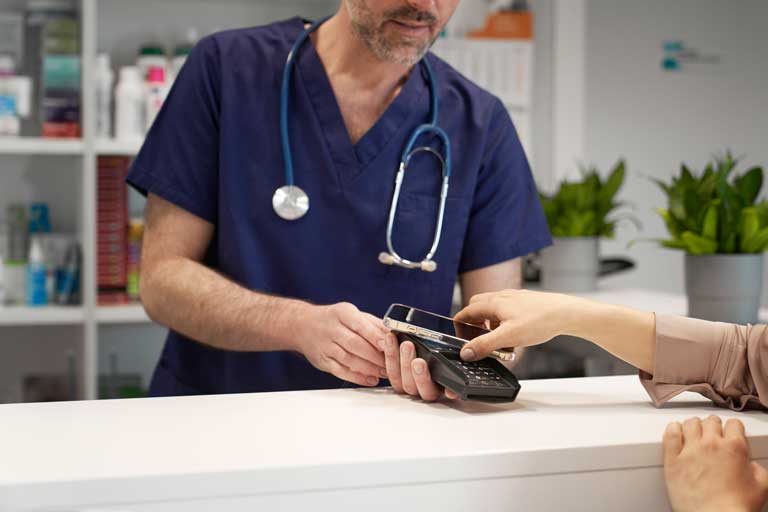If your healthcare facility is not already on the contactless payment train, you better climb aboard. Lacking in accepting the most widely adopted form of payment over the last two years will leave your business stranded and hurting.
What Is A Contactless Payment?
A contactless payment is any type of transaction where a patient can complete their purchase without physically handing their card, cash, or check to another person.
COVID-19’s Role In Contactless Payment Acceleration
COVID-19 changed everything. From how we interact as a society, how we monitor our health, and even how we pay for our goods and services. Contactless payments existed decades before the COVID-19 pandemic. However, only a mere 30% of transactions were contactless even in 2019.
It wasn’t until 2020 and 20201 that the globe experienced a surge in touchless transactions. With the widespread fear of viral infection through social contact, the adoption of contactless payments skyrocketed to 80% globally. This means the majority of the world market was handling all transactions in the form of contactless payment.
The majority of the world’s industries such as retail, public transit, and restaurants had to adopt contactless payment solutions. And today, they are still embraced. Not only are contactless solutions safe, effective, and convenient, they have escalated positive customer experience. It is in the best interest of the healthcare industry to follow suit.
When the Coronavirus was on the rise, healthcare organizations were dramatically affected. In response to the pandemic, health systems had to step up their protocols to safely accommodate visits and optimize patient encounters. This included the accelerated adoption of numerous innovations in safety, workflow, procedures, and yes, payment methods.
The enhanced protocols from 2020 remain in place. They are critical to continue to reduce potential viral exposure during the intake process, check-up appointments, and procedures.
Statistics Supporting Contactless Payment Adoption in Healthcare
We already discussed how 80% of global transactions have become contactless due to health and safety concerns that arose in 2020. Additionally, in the healthcare industry alone, surveys indicate contactless solutions have no sign of slowing down. Below are a few numbers that support this:
- 19% of Americans made a contactless payment for the first time in 2020. The majority who utilized this technology said they would continue to use it after the diminishment of pandemic safety protocols.
- 43% of healthcare patients expressed interest in the overall scope of digital payments.
- 56% of healthcare patients said that their financial experience impacts their healthcare choice. If they had a better payment experience elsewhere, they would consider switching healthcare facilities.
- 32.5% of healthcare patients are motivated to switch healthcare providers if they have the option of digital and online payments.
Better payment experience includes the option of using contactless methods to pay. Surveyed patients indicated the below are their desired choice of contactless payment:
- Mobile wallet (25%)
- Mobile app (32%)
- Patient Portal (37%)
In-Office Contactless Solutions in Healthcare
According to recent reports, contactless payments are the number one desired transaction method for today’s patients. Patients can use a variety of methods to complete a contactless payment.
As a provider, you will need to consider which option you can easily supply to your patients. You will need to use hardware and/or software that accepts contactless payments.
If you currently do not have the right tools, you can reach out to your payment provider to upgrade your equipment. If you currently do not have a payment processor, you can contact ECS, where we will be happy to help get you started.
Additionally, you will need to understand which method makes the most sense for your specific patients. This includes the type of appointment and its environment. On-site, off-site, remote, pre-pay, bill pay, etc. These methods can be one of the following methods:
Tap-To-Pay Contactless Solutions
Tap-to-pay solutions allow patients that are onsite to check in or out without having to touch a physical card reader or keypad. tap-to-pay uses an NFC-enabled credit card, debit card, or mobile phone. Simply hovering these cards and mobile phones over a contactless terminal for a second completes a transaction.
Contactless cards and mobile devices use radio frequency identification (RFID) technology to emit radio waves from one equipped device to the other at a short-range distance. Contactless cards and all modern mobile devices have an internal NFC chip embedded into them. This chip facilitates contactless transactions.
Keep in mind that to use RFID technology, you will need to have a card terminal equipped with near-field communication (NFC) capabilities.
NFC-Enabled Credit or Debit Cards
NFC-enabled credit cards and debit cards are more popular than ever. Issuing banks are now sending all replacements for expired or lost cards with updated contactless versions. If a card is enabled with NFC technology, it will be recognizable with a small symbol that resembles a Wi-Fi icon.
Contactless Mobile Wallets
Mobile wallets also use the tap-to-pay technology we discussed above. However, mobile wallets offer an additional advantage that contactless cards do not offer. With mobile wallets, patients can leave their wallets at home. Patients can use their phones, which they typically always carry with them to complete the payment at check-in and check-out.
A mobile wallet is an application that all smartphones support. This app safely stores credit card and debit card information electronically in lieu of cash or physical cards. A cardholder would simply need to open their device’s integrated application and enter their card information once. After that, they can use their phone or even smartwatch to pay for transactions at medical practices that have contactless supported payment terminals.
Furthermore, mobile wallets can also manage driver’s licenses, identification cards, boarding passes, event tickets, and loyalty program cards. The mobile wallet application would be dependent on the smartphone brand. All mobile wallets support card brands such as Visa, Mastercard, American Express, and Discover. The most common mobile wallet applications are:
- Apple Pay for iPhone
- Google Pay for Android
- Samsung Pay Samsung
Card-On-File in Healthcare
An additional way to cut back on unnecessary contact and provide convenience for patients is to keep their card information on file. Providers can securely store card data in an online vault in their virtual payment terminal. When a patient checks in or out for their appointment, you can simply ask if they want to use the card on file to pay. With this option, the patient wouldn’t need to lift a finger to complete their payment.
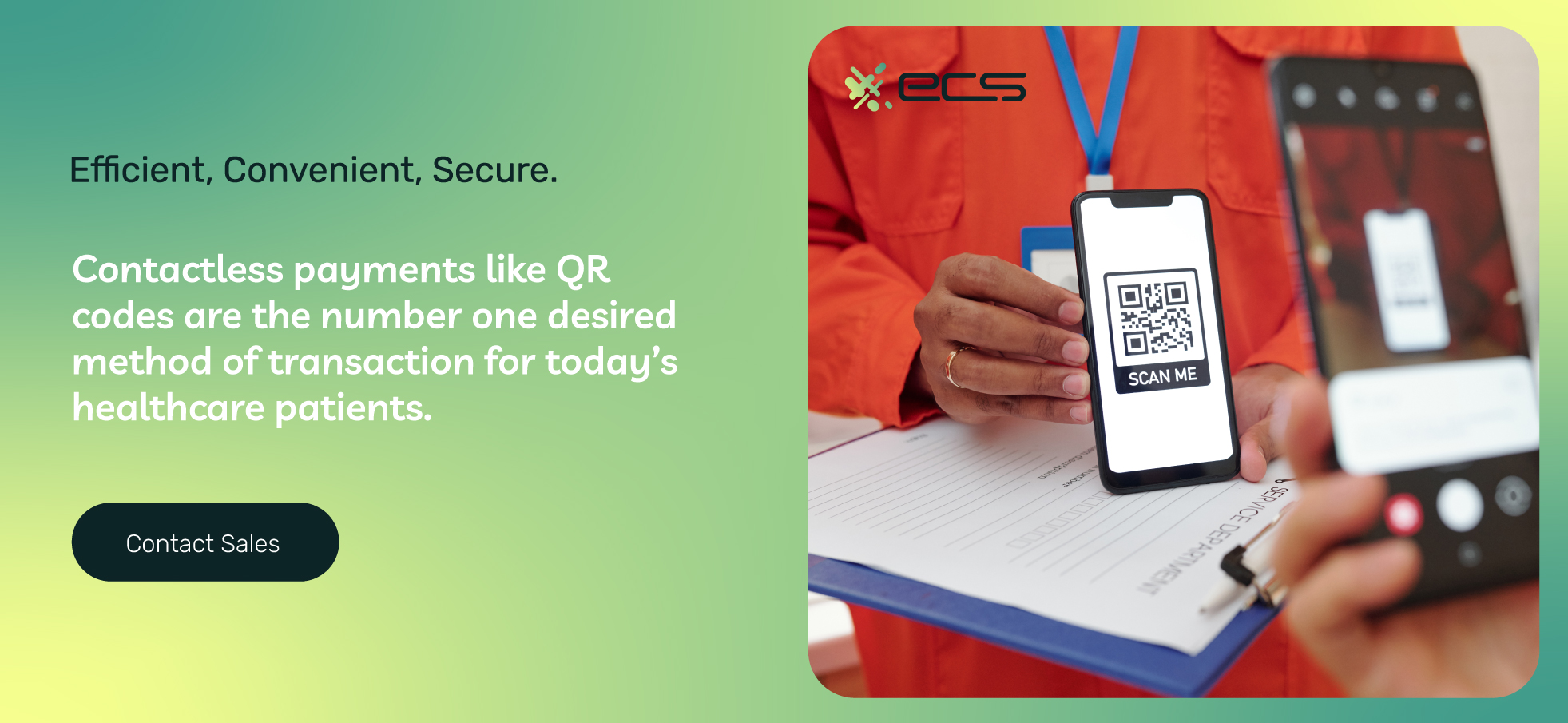
Using QR Codes For Contactless Healthcare Solutions
The last way contactless transactions can occur is with the use of a quick response (QR) code. A quick response (QR) code is a high-speed square “barcode” with multidirectional scanning capabilities.
To read a QR code, a user would simply open up the camera on a mobile phone, and hold it over the image. Once read, the QR code will generate a clickable website link. The website can take your patient to their portal, a check-in landing page, or a payment screen. QR code advancements guide patients through an ultimate touch-free, convenient, and safe user experience.
A patient can use a QR code to:
- Check-in for their appointment
- Fill out their medical history
- Sign any necessary forms
- Make a one-time payment
- Set up a recurring payment
- Browse your website
- View any additional information
Out-Of-Office Contactless Solutions
If a patient needs to pay a bill after a visit or pre-pay for an appointment, you can offer several contactless payment options.
Patient Payment Portal
Patient payment portals are genuinely effective in providing convenience to your patients. Whether your patient is in the office or at home, they simply log into their profile and securely pay online. There is no requirement for person-to-person contact. And no sending of checks or phone calls with their card information when they receive a bill after a visit.
Patient payment portals would use a virtual payment gateway to collect card information. Card information is entered either manually, auto-filled with a mobile wallet, or through a digital wallet like Paypal or Zelle. Digital wallets transfer funds using a person’s bank account and routing number rather than a credit card or debit card number.
Automated Payment Plans
Additionally, patient payment portals can offer a feature for automatic payment plans or automatic bill pay. Setting up automatic payments reduces responsibility and stress on the patient.
They don’t need to remember to make their payment. It is handled automatically, without hassle. It also ensures there are no missed or late payments, so your practice receives timely payment in full.
Using Text-To-Pay (SMS) in Healthcare
Patients can set up payment after receiving a text message from your office. A texted link will take them directly to a secure online terminal. They can enter their card information right on their phone or use their stored card information on their mobile wallet.
Advantages Of Contactless Payments In The Healthcare Industry
The payment habits that evolved during the wake of COVID-19 are without a doubt here to stay, for numerous reasons. Over recent years, there have been many discoveries of the benefits contactless payments have to offer. Health and safety concerns drove the rapid shift toward contactless payments in 2020. However, the additional benefits for patients below continue to make this method of payment favorable to patients:
1. Health & Safety
COVID-19 brought on a heightened awareness of the spread of communicable diseases. However, there was little known information about how the Coronavirus was spread. Was it by air droplet, by physical contact, between contaminated surfaces? It was unclear in the beginning.
Regardless of how the virus was transferred, patients and medical staff alike desired clean and safe healthcare and a point-of-sale environment. In fact, 76% of patients say they are looking for not only the safest treatment but also the safest way to pay for their services. Contactless transactions allow patients to avoid having to touch a possibly germ-covered payment terminal or keypad.
Digital Intake Experience
There is a risk of contamination in any standard check-in and payment process. Waiting rooms used to make social distancing difficult. Patients had to check in with a staff member at the front desk and then sit next to another patient while waiting to hear their names be called. Additionally, handling cards or cash at check-in and check-out can spread bacteria and illnesses.
However, embracing digital patient intake with a contactless check-in and payment experience keeps patient and staff safety in mind with a more sanitary environment.
First, a patient receives a text message or email. This will contain a registration link for their upcoming appointment. They can complete this form from anywhere on their computer or mobile device.
Next, patients notify the front-office staff that they have arrived for their visit through a phone call or text message while they wait in their car outside the medical facility. Medical staff can then manage check-in remotely without physically handling a patient’s credit card, insurance card, ID, or paperwork.
Lastly, patients receive a text to notify them that their room is ready. The patient can then enter the building and head straight for their designated room without having to closely interact with anyone in a waiting room.
Offering a touch-free experience reduces unnecessary face-to-face interaction during check-in. With zero physical contact between person to person and person to a device, the point-of-sale environment and medical office are more hygienic than ever. It allows medical staff to cut back the time taken to sanitize all surfaces. In return, they can focus more on providing quality care to patients.
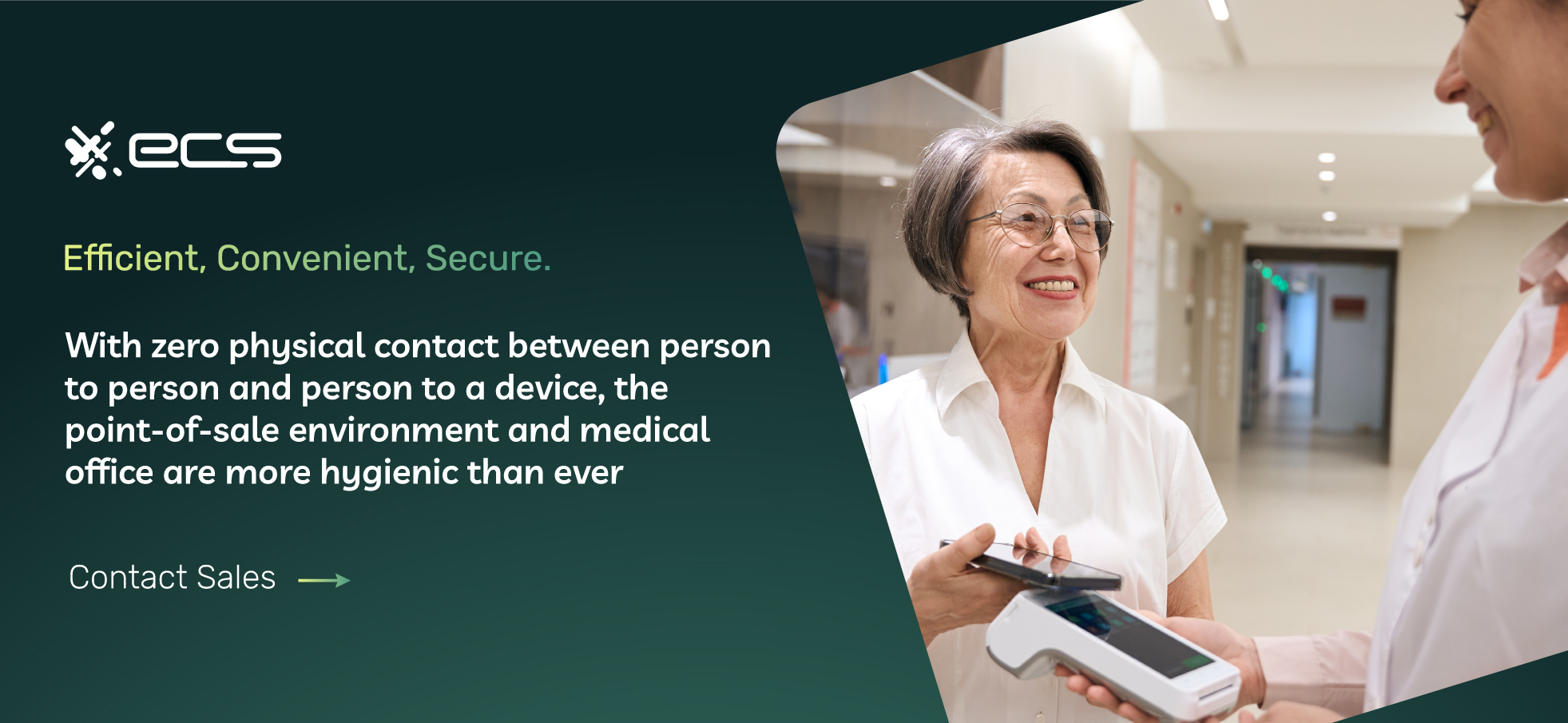
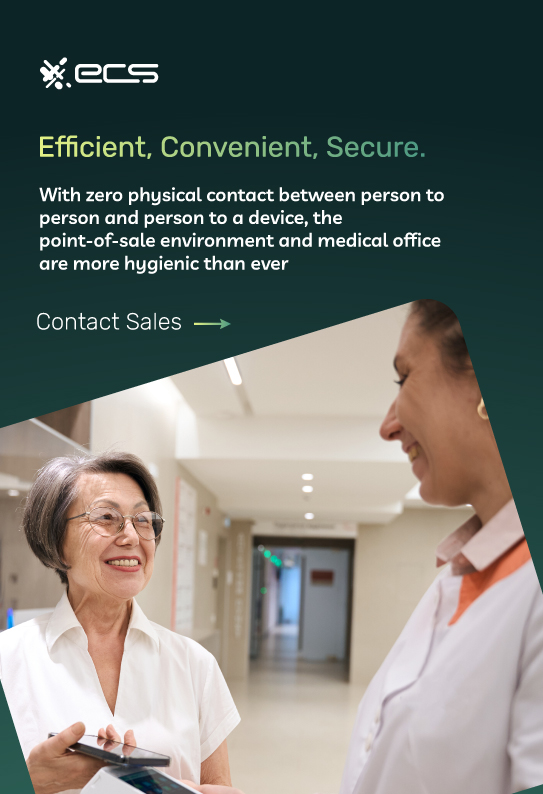
2. Patient Convenience
Prior to the pandemic, patients looked for the same convenience from their medical experiences as they already had received from other industries. The pandemic had only amplified those expectations. It has become more important than ever for healthcare systems to prioritize a seamless patient experience. Daily and long-term strategies should foster it from start to finish.
Contactless solutions offer transactional ease. With the flexibility of the numerous contactless payment options, consumers have more control over the payment process. With the adaptation of any of these methods, your facility can supply its patients with much-needed convenience in a situation that may already be less convenient than desired.
There are a variety of options patients can choose from, depending on what is most convenient for them. Mobile wallets allow patients to leave their physical wallets at home and carry their pre-loaded card information with them right on their phones. Waving a mobile device over a contactless reader is much more convenient than fumbling through a heavy purse for cash, credit card, or checkbook.
Additionally, if a patient is not in the office when they need or want to make a payment, online payments come in handy. Online payments can utilize text-to-pay, patient portals, card-on-file, or QR codes. Patients can pay for services from anywhere, including from the comfort of their homes before or after an appointment.
3. Efficiency For Healthcare Staff And Providers
Not only is contactless payment convenient for patients, but it is also more efficient for front office staff. It alleviates unnecessary administrative burdens. Contactless payments process immediately. This increases efficiency and productivity in your medical practice.
Alternatively, with cash, a staff member would need to check for legitimacy and double-count the amount. They may also need to offer change and handwritten receipts.
Additionally, with paper checks, staff would need to deposit the funds by scanning the check or making a trip to the bank. Which could then bounce a few days later if there are insufficient funds. Checks take longer to process and receive a settlement.
Moreover, contactless intake and payment yield more efficiency for providers. Healthcare providers can embrace a modern care model that better meets the expectations and needs of patients.
Patients can fill out all of the necessary intake forms prior to their appointment from their device at any location. Completing intake tasks in a personal environment, rather than in a bustling waiting room, may help encourage patients to give more detailed answers on their forms. This results in a more comprehensive and productive appointment with their provider.
4. Speed
Magnetic stripe and EMV chip card transactions are most definitely quicker than paying with cash or check. However, contactless payments are even more instantaneous. A swiped or dipped transaction takes about 3 seconds to process card data. Whereas, a “tap-to-pay” transaction or contactless payment takes less than two seconds to complete.
Rapid transaction times can reduce long check-in and check-out lines. Slow-moving lines can cause frustration. Patients may feel their time is not valued at your practice. When you provide contactless payment solutions, you are ensuring your patients that you value their time.
5. Patient And Data Security
The medical field is well aware of patient security. Any provider in the healthcare field has HIPAA regulations ingrained into their core. HIPAA policies protect patients’ medical information from being shared without their permission. The same should apply when it comes to their payment information.
When patients can use a contactless method to complete a transaction, they can rest assured their payment information is secure, encrypted, and tokenized. Contactless protection measures make it extremely difficult for a hacker to access card information. This dramatically reduces any risk of theft and fraud.
- PCI Compliance– Contactless payment technology complies with the Payment Card Industry Data Security Standard (PCI DSS). The card brand networks require and monitor PCI compliance. Merchants who accept card transactions must adhere to a set of 12 operational standards of PCI compliance.
The design of this set of standards protects cardholder data during transactions. If a merchant were to be non-compliant, they accumulate hefty fees or lose their merchant account altogether. - Mobile Wallet Encryption– Full card numbers and personal information is always encrypted when entered into a mobile wallet application. If someone were to get ahold of the device, they would not be able to view card data.
- Transaction Tokenization– Contactless payments using a mobile wallet offer transaction security. Each transaction creates a token with a one-time code. Securing card information. Information such as the verification code (CVV), cardholder address, and cardholder name is not transmitted as they would be with swiped and dipped payments.
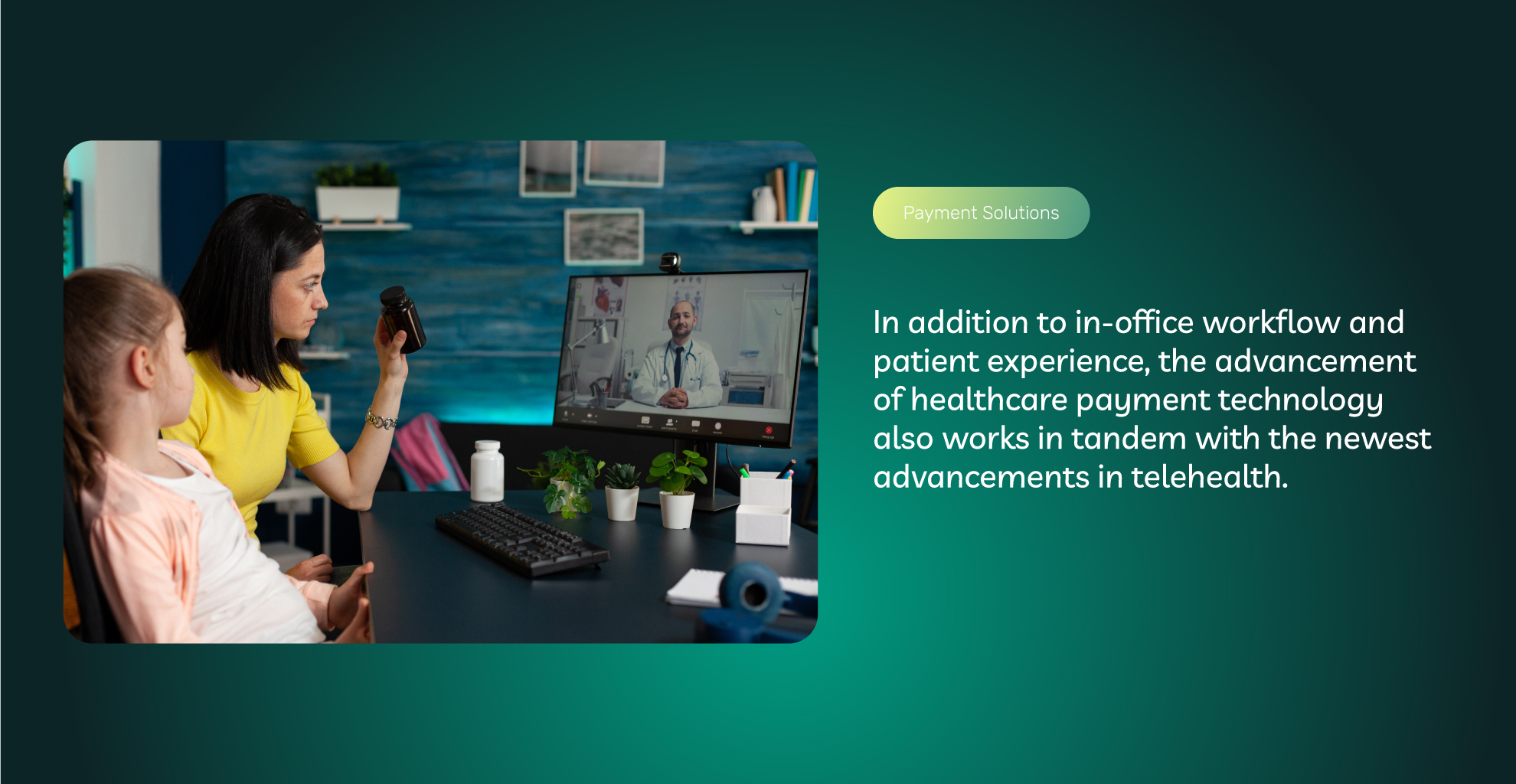
6. Support For Various Healthcare Appointment Environments
Medical practices are now, more than ever, facing ongoing challenges of rapidly changing healthcare environments. Implementing contactless patient intake and payment solutions can support numerous appointment workflows and climates. It provides a streamlined and safe experience for both patients and staff.
The pandemic prompted healthcare facilities to seek out new ways to conduct appointments aside from the standard exam room/in-office appointment. This includes but is not limited to triage tents, drive-through visits, and virtual appointments.
Contactless patient intake can facilitate easy registration, check-in, and payment. All without being stuck to countertop terminals and requiring strict forms of payment like traditional credit cards, cash, or check-in an abnormal environment.
In addition to in-office workflow and patient experience, the advancement of healthcare payment technology also works in tandem with the newest advancements in telehealth. The wide adoption of telehealth in recent years is supplying a safer, more convenient patient experience. A patient can meet with their provider without having to leave their home. They simply schedule an appointment online, open their computer, and connect to their doctor via webcam.
Granted, specific tests cannot be virtually run. However, sometimes all you need is to speak with your provider for an opinion, advice, a referral, or a doctor’s note. Many people will jump at the opportunity to not have to drive all the way to their doctor’s office. With the convenience that telehealth offers, payment acceptance should be equally convenient.
With the barrier of the computer screen, telehealth also limits physical interactions. This keeps contamination down. Which results in a zero percent chance of infection. With the newness of COVID-19 in 2020, reports indicate that 65% of patients had utilized telehealth services.
7. Customer Service And Patient Retention
With a variety of payment options, your practice can cater to a broader range of patients. Additionally, you will dramatically increase a positive patient experience no matter the type of appointment environment.
No patient is happy when told the facility they are being treated in only accepts cash or check. Especially when most people tend to solely carry cards in their wallets or their phones with their mobile wallets. When you offer more ways to pay with added convenience, safety, security, and ease, patients will know that you care about their needs and their time.
Memorable customer service at check-in, check-out, and during appointments will lead to patient retention and loyalty for years to come. Medical providers who do not initiate or keep the added conveniences and safety that contactless payments offer after the pandemic ceases will struggle to compete.
8. Tech-Savvy Generations
As technology advances by the year, each new generation, Gen Z, Millennials, and Gen Alpha are becoming naturally more and more tech-savvy from birth. These generations will ultimately continue to drive the advancements in digital payment technology.
Younger, progressive generations will expect the most advanced technology throughout their patient experience. This will include platforms that support paperless, contactless, and mobile-friendly registration, check-in, and payment.
A cashless society is rapidly approaching. Eventually, the only means of payment will be by way of digital currency. This means the need for cutting-edge contactless payments will continue to dominate the industry in the years to come.
9. Contactless Payments are the way of the Future
Covid-19 accelerated the increased need and patient demand for contactless payment solutions. However, looking into the future, experts agree that this safe and effective way to pay in the healthcare industry is here to stay.
Patients are now pampered with the convenience of paying directly with their smartphones or online from the comfort of their homes. In fact, it has become the new normal. Patients expect modern innovation when visiting their healthcare office from the check-in process to the medical technology at their appointment.
The more modern advancements your office can display, the more your patients trust you will be taking the best care of them. Going back to scavenging for cash or paper checks at the bottom of purses or wallets after the pandemic would be regressive and rudimentary.
Contactless payments help providers deliver a quality patient experience from check-in to check-out. It also helps to maximize collections. Ensuring you receive efficient payment from patients.
Recent years have taught us that touch-free payment technology is ever-increasing in popularity. Experts expect the contactless payment market to see a compound annual growth rate of 11.7% and a value of $18 billion by 2025.
Choosing to maintain modernism in payment acceptance is essential to stay competitive and relevant in the healthcare industry. Innovative payment processing will provide your patients with the ultimate service. It will also save your practice time and money. Your practice and your patients will reap the many benefits of contactless payments, regardless of whether you implement one, several, or all options.
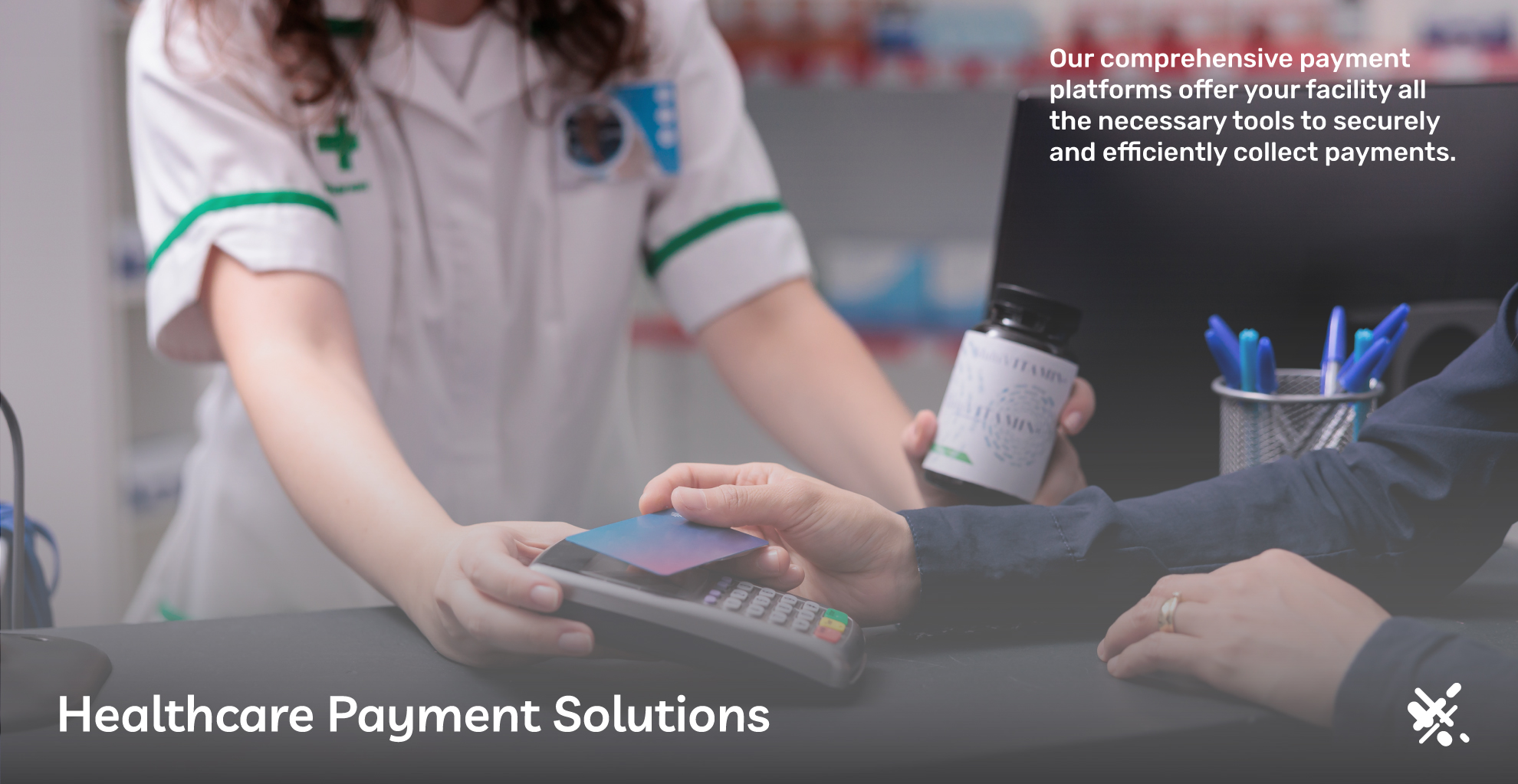
Contactless Payment Solutions for Healthcare Providers from Electronic Payment Solutions (ECS)
You’ve now grasped an understanding of the many benefits contactless payments can provide you, your business, your staff, and your patients. Now it’s time to make sure you are taking advantage of them.
ECS has worked in the healthcare payment industry for decades. It is our privilege to provide payment solutions for dozens of healthcare facilities. Our comprehensive payment platforms offer your facility all the necessary tools to securely and efficiently collect payments.
Additionally, our customizable contactless solutions use all the above modern technologies that will add convenience to your life and your patients. Increasing your collections and profit margins.
If you are ready to get started you can reach out to us here and one of our experts will be in contact with you shortly.
Practice Management Bridge Software
Beyond all the benefits contactless payments can bring, we’d like to discuss how implementing practice management bridge software can further streamline your medical practice.
ECS has teamed up with Practice Management Bridge software to conquer the challenges healthcare providers face. Often burdened by administrative tasks, healthcare providers can rely on Practice Management Bridge software to streamline their front-office, back-office, and payment processing tasks all in one state-of-the-art platform.
The ECS and Practice Management Bridge partnership offers healthcare providers a range of patient solutions, including point-of-care payments, online and mobile payments, QR codes on bills or in-office, digital patient forms, patient financing and payment plans, and enhanced payment security measures.
With about 60% of the workforce enrolled in high-deductible health insurance plans, out-of-pocket patient costs have reached $433 billion, placing a financial strain on patients and contributing significantly to high debt in the healthcare industry.
Medical surprises, such as the heightened prevalence of diabetes, heart disease, and cancer, on top of preventative care, palliative care, and standard care for women such as OB GYN and labor and delivery, further exacerbate the medical debt problem. Americans continue to face growing healthcare challenges amongst stagnant wages and inflationary costs of living.
It is no surprise that patients struggle with medical debts. And antiquated medical practice’s billing processes such as paper record-keeping adds to the debt the issue, with the cost of processing paper invoices ranging from $12 to $30. There needs to be resources for both patients and practice’s to reduce their costs and wisely gain control of their finances.
That’s where Practice Management Bridge and ECS come in. We offer our solution with digitized and streamlined payment processes. Our cutting-edge point-of-care payments, including online and mobile payment options, QR codes, and digital patient forms enhance the patient experience and reduce administrative burdens.
Additionally, we make it easy to customize patient financing options and payment plans to help address the diverse financial situation of every patient, ultimately, increasing the likelihood of successful payment collection for your practice. And rest assured ECS’s robust security measures ensure compliance with payment industry standards when transferring and storing patient card information on file.
The benefits of using this platform is substantial, including a:
- 20% reduction in billing management time
- 25% improvement in payment reconciliation
- 90% reduction in manual refund processing
- 5% increase in payment collections
In essence, ECS and Practice Management Bridge offer a comprehensive solution to the complex challenges healthcare providers face, especially when it comes to payment processing, empowering them to focus on what really matters. And that is patient care.

Concluding Contactless Payments For The Healthcare Industry
Contactless encounters are crucial at this point. Especially in the medical industry. During the pandemic, there was a 52% decrease in adult primary care visits. Only after implementing more contactless solutions have these appointments returned to pre-pandemic levels.
Contactless check-in, check-out, registration, and payment are being done easier and safer than ever. All thanks to the implementation of patient portals, QR technology, contactless cards, mobile devices, and digital wallet applications.
To contact sales, click HERE. And to learn more about ECS Contactless Payments visit Contactless.
Updated January 2024
